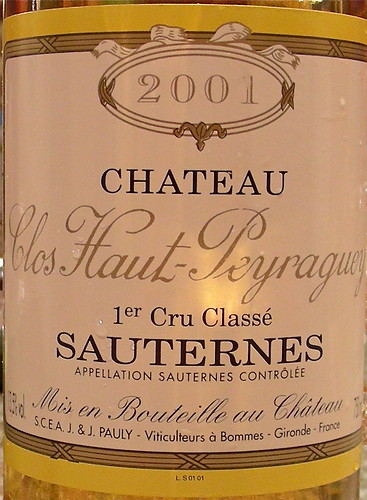
My husband's foie gras
Sauternes is the classic pairing with foie gras as the luxurious sweetness of wine is able to stand up to the rich fatness of the foie gras. These wines come from the Sauternais region located 40 km (25 miles) southeast of Bordeaux along the Garonne river and its tributary, the Ciron. The Ciron river has cooler waters than the Garonne and in autumn, when the spring-fed stream of the Ciron River meets the warmer Garonne, mists develop and stay in the vineyards from evening to late morning. This moisture promotes the development of the Botrytis cinerea fungus on the grapes. However, by mid day, the sun helps dissipate the mist and the infection can develop into noble rot rather than the malevolent grey rot. Noble rot removes water from the grapes and causes the grape to concentrate sugars and flavors while maintaining high levels of acidity. It also affects the grape's flavor compounds and that's what differentiates botrytied wines from wines that are sweet because of fortification, drying, or being harvested late.
In the Sauternais, harvests are very labor-intensive and costs of production are high. During harvest, skilled workers hand-pick only berries that have been properly infected with the fungus and multiple passes throughout the vineyard are required over a couple of weeks.
 Château d'Yquem is the most famous of all the Sauternes. The Yquem property once belonged to Eleanor of Aquitaine as part of her duchy. It was also Thomas Jefferson's favorite white wine: during a visit to the Château, he ordered 250 bottles of the 1784 vintage. Château d'Yquem is the only white Bordeaux rated Premier Cru Supérieur (Superior First Growth) by the Bordeaux Classification of 1855.
Château d'Yquem is the most famous of all the Sauternes. The Yquem property once belonged to Eleanor of Aquitaine as part of her duchy. It was also Thomas Jefferson's favorite white wine: during a visit to the Château, he ordered 250 bottles of the 1784 vintage. Château d'Yquem is the only white Bordeaux rated Premier Cru Supérieur (Superior First Growth) by the Bordeaux Classification of 1855.1991 was a difficult vintage in the Sauternais. It was characterized by a devastating spring frost followed by a hot summer. Then storms in August prompted botrytis to attack the vines and picking began early in late September. Harvest workers had to avoid picking the grey rot infected berries.
When we poured the 1991 Château d'Yquem, it showed a beautiful deep amber color. The nose had subtle aromas of honey and dried apricots. On the palate, the wine was not overly sweet, unctuous with some acidity, and a touch maderized, which somewhat added an unusual layer of complexity. The best was taking a sip of it just after a piece of foie on toast sprinkled with coarse sea salt.
Technorati tags: wine food & drink




